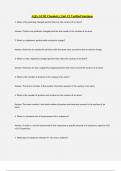Exam (elaborations)
AQA GCSE Chemistry Unit C2 Verified Solutions
- Institution
- AQA GCSE Chemistry Unit C2 Verified Solutions
AQA GCSE Chemistry Unit C2 Verified Solutions 1. What is the positively charged particle found in the nucleus of an atom? Answer: Protons are positively charged particles that reside in the nucleus of an atom. 2. What is a subatomic particle with no electric charge? Answer: Neutrons are sub...
[Show more]



